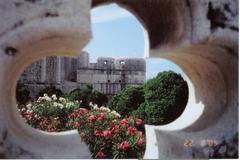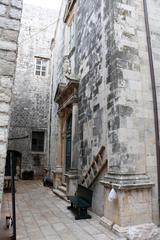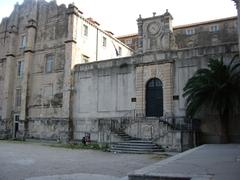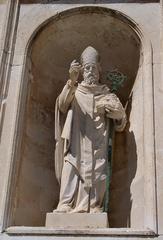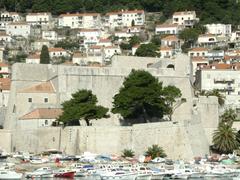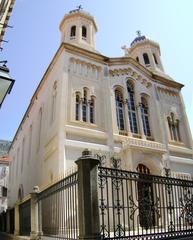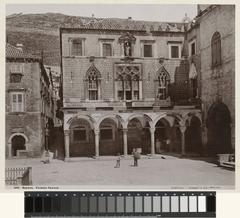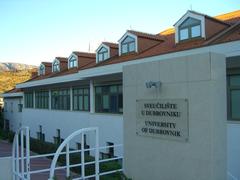Marin Držić Theatre Dubrovnik: Visiting Hours, Tickets, and Historical Significance
Date: 04/07/2025
Introduction
Nestled in Dubrovnik’s UNESCO-listed Old Town, the Marin Držić Theatre is a vibrant emblem of Croatia’s rich cultural and theatrical heritage. Named after the city’s illustrious Renaissance playwright, Marin Držić (1508–1567), the theatre weaves together centuries of dramatic tradition, architectural splendor, and community engagement. This guide details the theatre’s history, visiting hours, ticketing, accessibility, and nearby attractions, serving as an essential resource for anyone planning to explore Dubrovnik’s cultural heart.
(official website, hello-dubrovnik.com, The Dubrovnik Times)
Early Theatrical Traditions in Dubrovnik
Theatrical life in Dubrovnik began in the Renaissance, with performances staged in open courtyards and civic spaces, particularly in front of the Rector’s Palace. These early events featured amateur troupes and were deeply rooted in local civic culture. A major milestone occurred in 1551 with the premiere of Držić’s comedy “Uncle Maroje” (“Dundo Maroje”), marking Dubrovnik’s early embrace of dramatic arts and establishing Držić as a foundational figure in Croatian theatre (The Dubrovnik Times).
The Evolution of Theatre Venues
After the devastating earthquake of 1667, Dubrovnik’s first dedicated theatre was established in the Arsenal, a repurposed shipyard, in 1682. The Orsan Arsenal remained the main indoor theatre until 1808. Post the fall of the Dubrovnik Republic, the theatre moved to the Great Council Hall, which operated as Kneževsko Kazalište (Duke’s Theatre) until it was destroyed by fire in 1817 (tzdubrovnik.hr).
During Austrian rule, theatrical performances continued in adapted spaces like the Gozze (Gučetić) House. Recognizing the growing cultural demand, the city constructed the Bondin Teatar in 1865, a grand 19th-century venue financed by Luko Bonda (Bundić). Its opening was marked by a performance of Verdi’s “Ernani,” and it quickly became Dubrovnik’s cultural hub (The Dubrovnik Times).
Post-War Transformation and the Modern Theatre
Re-established as Narodno Kazalište Dubrovnik (Dubrovnik National Theatre) in 1944, the theatre entered a new era of professional performance and cultural promotion. In 1967, on the 400th anniversary of Držić’s death, the theatre was renamed in his honor, reflecting his enduring influence on Croatian and European drama (tzdubrovnik.hr).
Architectural and Artistic Features
The Marin Držić Theatre’s 19th-century building exudes Central European elegance, with an eye-catching façade and intimate interior. Notably, the ornate ceiling, painted by Vlaho Bukovac in 1901, depicts “Double Coronation in Heaven and on Earth,” symbolizing Dubrovnik’s civic pride. The ceremonial curtain, added in 2008 by Matko Trebotić, features scenes from urban life, further connecting the theatre to its living heritage (tzdubrovnik.hr).
Marin Držić: The Theatre’s Namesake
Marin Držić is celebrated as Croatia’s greatest playwright and a pioneer in Renaissance European comedy. His works, characterized by sharp wit and social critique, are still staged in Dubrovnik and influence theatre across Europe. The theatre remains dedicated to preserving and promoting Držić’s legacy (muzej-marindrzic.eu).
Visiting the Marin Držić Theatre: Practical Information
Visiting Hours
- Performances: Generally Tuesday through Sunday, with both matinee and evening shows.
- Box Office: Opens at 10:00 AM and closes after the final performance of the day. Always confirm current hours on the official website.
Ticket Prices
- Standard tickets range from 50–150 HRK (approx. 8–20 EUR), depending on the production and seat.
- Discounts for students, seniors, and groups.
- Special events and festivals may have higher prices and require advance booking.
Accessibility
The theatre is wheelchair accessible and offers assistance for visitors with disabilities. Notify the box office in advance to ensure suitable arrangements.
Guided Tours
Guided tours are available on request, particularly during festivals or by prior arrangement. These tours provide insights into the theatre’s rich history, architecture, and artistic treasures.
Nearby Attractions
Located in the Old Town, the theatre is within walking distance of:
- Rector’s Palace
- Dubrovnik Cathedral
- City Walls
- House of Marin Držić museum
Special Events
The theatre is a key venue for the Dubrovnik Summer Festival, which features over 60 events citywide, and the Midsummer Scene Festival, known for English-language productions. For current schedules, visit Croatia Week and Midsummer Scene.
Visitor Experience
Arrival and Entry
The theatre’s central location makes it easy to reach on foot from any part of the Old Town. Upon arrival, guests are greeted by the historic façade and lively square, often animated by street musicians and locals.
Seating and Accessibility
With approximately 350 seats arranged across three levels, the theatre offers excellent sightlines and acoustics. While the historical building poses some accessibility challenges, staff are available to assist those with mobility needs (Dubrovnik Sun Gardens).
Ambiance
The intimate auditorium, lavishly adorned interiors, and Bukovac’s stunning ceiling create a warm and inviting atmosphere. The audience is typically a mix of locals, tourists, and theatre enthusiasts.
Language and Subtitles
Most performances are in Croatian, especially classic plays. During festivals, English-language productions are featured, and some shows offer subtitles or printed synopses (Midsummer Scene). Always check performance language when booking.
Dress Code and Etiquette
Smart-casual attire is recommended, especially for evening events. Arrive 15–20 minutes early. Photography and recordings are prohibited during performances; they are permitted in the lobby and exterior.
Amenities and Facilities
- Restrooms and cloakroom available.
- Small bar for refreshments during intermissions.
- Surrounded by Old Town cafés and restaurants (In Your Pocket).
Booking Tips
- Advance Booking: Recommended for popular shows and festivals.
- Language: Check if English performances or subtitles are available.
- Arrive Early: Enjoy the ambiance and architecture before the show.
Exploring Dubrovnik’s Historical Sites
Pair your theatre visit with a tour of nearby landmarks, including the Rector’s Palace, Sponza Palace, and the House of Marin Držić.
Frequently Asked Questions (FAQ)
Q: How do I buy tickets?
A: Tickets are available online, at the box office, or through the Dubrovnik Tourist Board.
Q: Is the theatre accessible?
A: Yes, with assistance available. Contact the theatre in advance for special accommodations.
Q: Are performances in English?
A: Some festival events are in English or have subtitles. Check the programme before booking.
Q: What attractions are nearby?
A: Rector’s Palace, Sponza Palace, House of Marin Držić, Stradun, and more.
Summary and Final Recommendations
The Marin Držić Theatre is a living monument to Dubrovnik’s artistic legacy, bridging Renaissance roots with a dynamic present. From its captivating performances and architectural marvels to its central role in major festivals, the theatre is a highlight for history buffs, culture seekers, and theatre lovers. Plan your visit around special events for a truly immersive experience, and explore nearby historic sites to enrich your journey through Dubrovnik.
Before visiting, always check the latest information on the official theatre website, and consider the combined museum pass for broader access to the city’s treasures (Museum of Modern Art Dubrovnik).
For the ultimate Dubrovnik experience, download the Audiala app for audio tours, schedules, and insider tips, and connect with us on social media for updates and offers.
Sources and Further Reading
- The Dubrovnik Times: Complicated History of the Theatre Scene in Dubrovnik
- Hello Dubrovnik: House of Marin Držić
- Dubrovnik Travel: Theatre in Dubrovnik
- Kazalište Marina Držića
- Croatia Week: Dubrovnik Summer Festival
- Midsummer Scene Festival
- Museum of Modern Art Dubrovnik – Opening Hours & Tickets
- In Your Pocket: Marin Držić Theatre
- Dubrovnik Sun Gardens: Dubrovnik Theatre
- muzej-marindrzic.eu: About House

